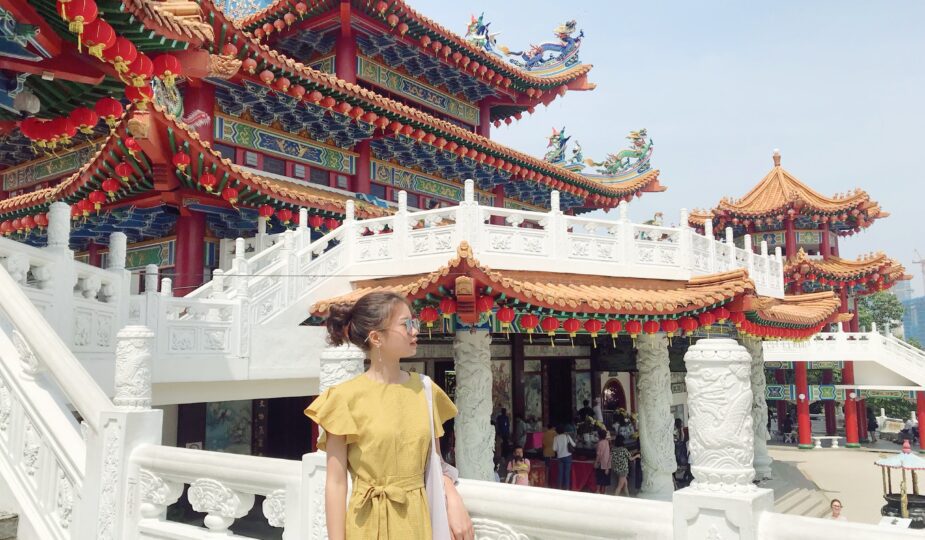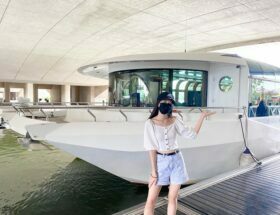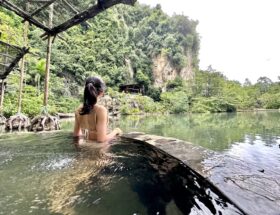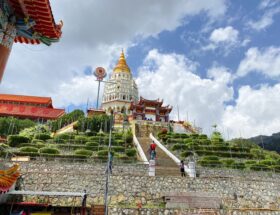DISCLOSURE: My articles may contain affiliate links. To click on those links, you won’t be charged any extra cost, instead, you help me to get some small commissions to maintain my blog. Thanks for understanding!
If you were to ask me which is the most beautiful attraction in KL, I would immediately answer, ‘It’s Thean Hou Temple.’
It is a renowned and visually captivating Chinese temple whose architecture harmoniously combines modern and traditional Chinese design elements.
I have visited this temple countless times, and the time when I find it most beautiful is probably during the Mid-Autumn Festival. Besides witnessing beautiful lantern exhibitions, I also had the chance to experience how the locals celebrate this festival.
In this blog post, you will find an insider guide to Thean Hou Temple, including information about its history, entrance fee, what’s inside the temple, the dress code, how to get there, and more.
Read more: Discover 25 incredible things to do in KL at night
Table of Contents
1. About Thean Hou Temple
Entrance fee
There is no entrance fee to Thean Hou Temple, but donations are warmly appreciated.
Location
The Thean Hou Temple sits atop Robson Heights, situated along Lorong Bellamy. From the temple, you can relish a panoramic view of both Jalan Syed Putra and Kuala Lumpur.
- Address: 65 Persiaran Endah, Off Jalan Syed Putra, Kuala Lumpur, Wilayah Persekutuan 50460
- Opening Hours: Daily: 08:00 – 22:00
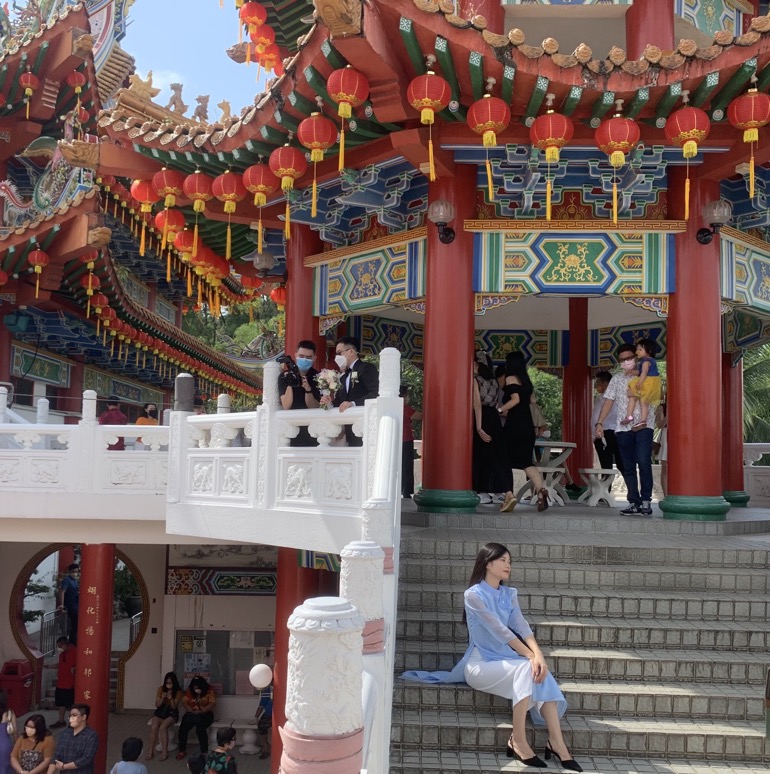
Brief history
The temple was completed in 1894 by the Hainanese community of Malaysia and was officially opened on 3 September 1989.
The total cost to complete Thean Hou Temple was about RM 7 million, which is equivalent to 1.5 million USD.
Who is Thean Hou?
Mazu, known as Thean Hou, is the Ocean Goddess originally hailing from Phuc Kien, China, renowned for her protective role over fishermen at sea.
Chinese communities hold a profound faith in her, constructing temples dedicated to her wherever they settle. Thean Hou temples can be found not only in Malaysia but also in other countries such as Singapore, Taiwan, and Vietnam.
People often visit Thean Hou Temple to pray for good fortune and blessings in their lives, especially during occasions such as Chinese New Year, the 1st and 15th day of the lunar month.
Marriage registration (ROM)
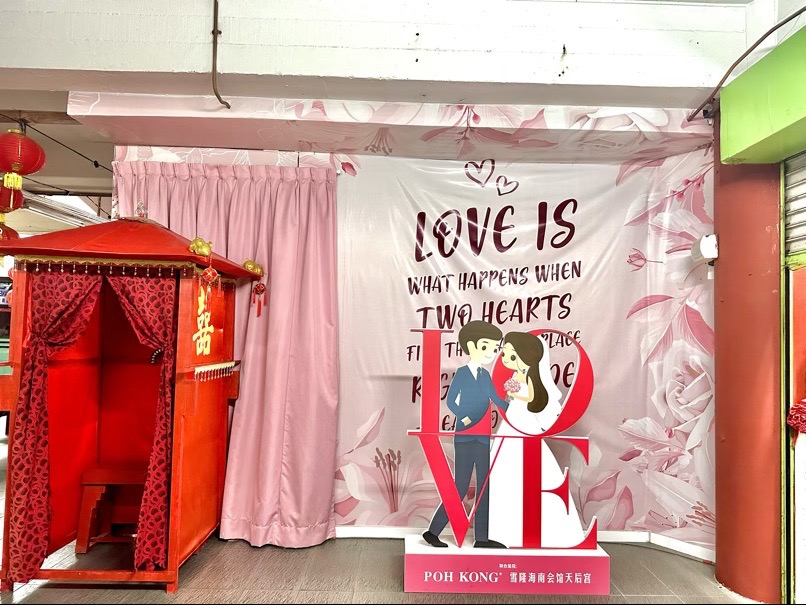
Thean Hou Temple is a popular choice among locals for wedding registrations (ROM – registration of marriage).
On the lower ground level, there are photo booths and wedding photography services available as well.
Thus, it’s common to see at least one couple capturing their wedding photos in the temple during your visit.
2. What’s inside Thean Hou Temple?
Main Prayer Hall
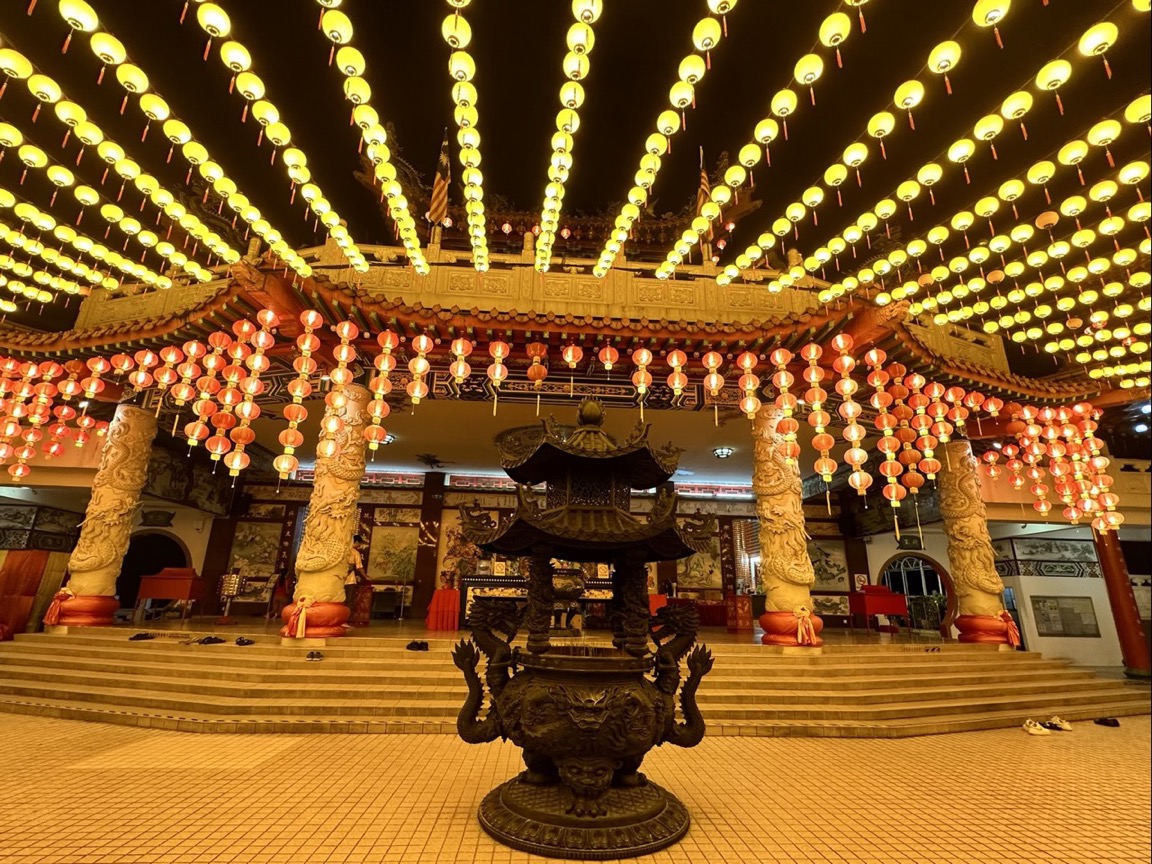
The main prayer hall is located on the second floor.
Outside the prayer hall, beautiful lanterns are hung on the roof.
Inside, you will find magnificent carvings and paintings on the pillars, beams, and ceiling. It houses altars dedicated to 3 deities, arranged from left to right as follows: Shui Wei Sheng Niang (the Goddess of the Waterfront), Tian Hou, and Guan Yin (Goddess of Mercy).
Fortune telling in Thean Hou Temple
It’s a tradition for Chinese people to engage in self-service fortune-telling when visiting a temple.
They shuffle sticks and let them fall randomly to the container, then select the highest stick and take the corresponding paper from a box.
These papers provide insights into various aspects of your life and your future, such as family, career, relationships, and upcoming obstacles. The content is not highly specific, but rather general.
To be honest, I don’t really believe in the content of the paper, but it did get me thinking a little about what it says about my life, haha.
12 Zodiac Animal Garden
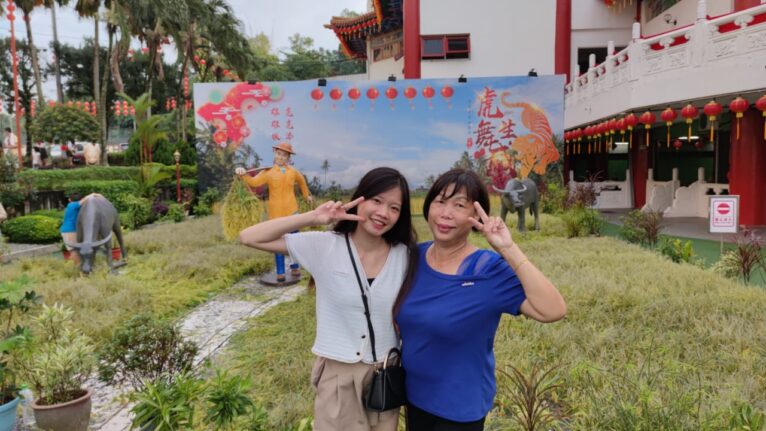
The garden is located next to the temple. It displays sculptures of 12 zodiac animals, and the zodiac animal of the year will be placed in the middle of the garden. As a result, you will see different decorations every year.
In Chinese culture, there are 12 zodiac animals in the following order: Rat, Ox, Tiger, Rabbit, Dragon, Snake, Horse, Goat, Monkey, Rooster, Dog, and Pig.
Each year is associated with a specific animal. For example, 2023 is the year of Rabbit, and 2024 is the year of Dragon.
These animals possess distinct traits and personalities, and it is believed that the characteristics of the animal representing the year of your birth are inherited by you.
I’m Vietnamese, and we also have 12 zodiac animals, which are the same as the Chinese ones, except for Rabbit, which is replaced by Cat.
My zodiac animal is Ox, and it is said that people born in the Year of the Ox are hardworking, reliable, and supportive of the people around them).
Yue Lao Statue – God of Marriage
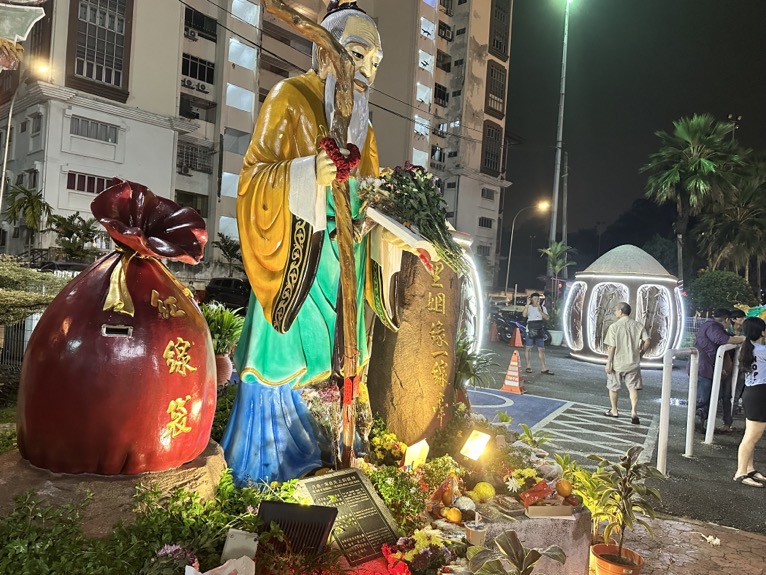
Near the 12 Zodiac Animal Garden, there is a statue of Yue Lao – the God of Marriage.
I saw people placing many offerings and praying, presumably about their relationships, in front of the deity.
Guan Yin Statue
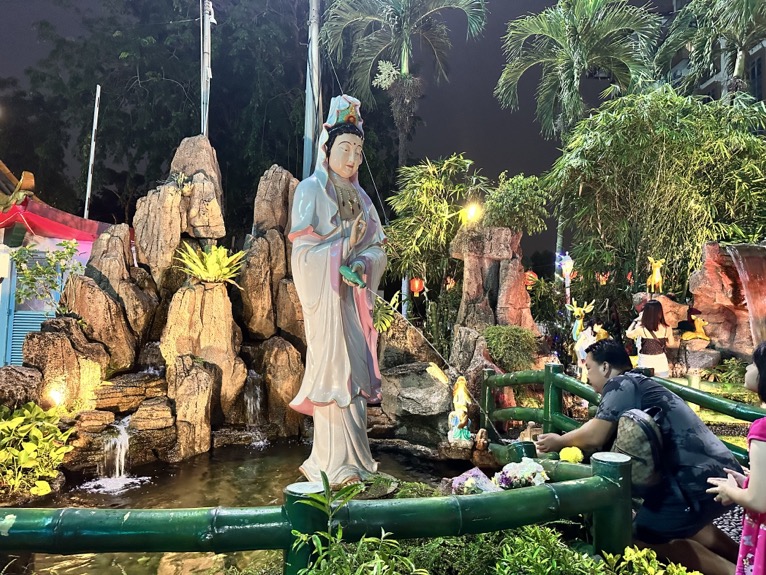
There are 2 Guan Yin statues in the temple. One is located in front of the temple, and the other is situated on the right side of the main hall.
Guan Yin, also known as the Goddess of Mercy, is a symbol of compassion. The most common depiction of Guan Yin is with her holding a water vase in her right hand and a willow branch in her left.
The vase is a symbol of good fortune, and the willow branch represents flexible yet unbreakable strength.
Culturally, people kneel down and pray in front of the Guan Yin statue, and they wash their faces with the holy water pouring out from her vase. It is believed that by doing this, you will receive good luck
Food Stalls and Souvenir Stores
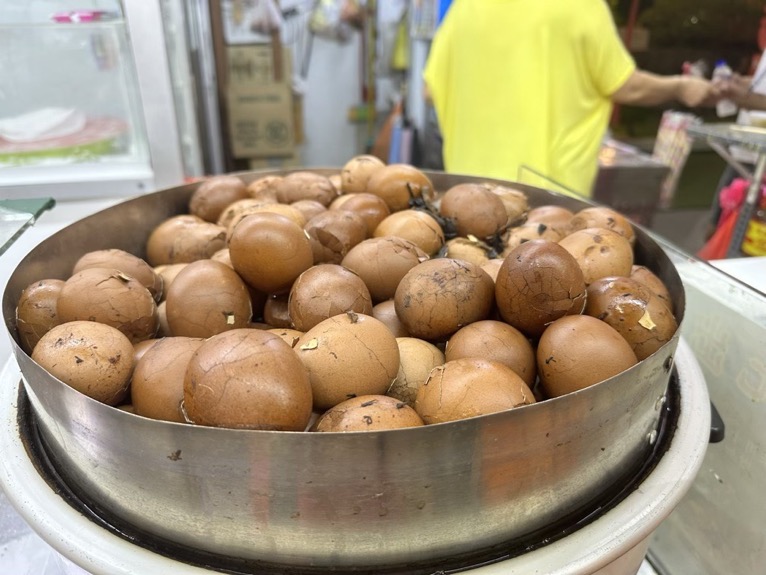
The lower ground floor houses many vegetarian food stores and souvenir stores.
You can buy some Tea Eggs (brown in color), which are eggs braised with Chinese herbs, resulting in a tasty flavor.
If you come during festivals such as Chinese New Year or Mid Autumn Festivals, you can see even more food stalls located outside of the temple (next to the parking area).
My review of other attractions in KL:
Festive decoration
When visiting Kuala Lumpur during special occasions like Chinese New Year (CNY), the Mid-Autumn Festival, Vesak (Buddha’s Birthday), and more, make sure to include Thean Hou Temple in your itinerary.
The temple is adorned with vibrant lanterns and sculptures that correspond to the occasion’s theme.
I’ve had the opportunity to visit twice during Chinese New Year, and each year, they transform the decorations to align with the zodiac animal of that particular year.
During the Mid-Autumn Festival, you should visit it at night when parents bring their kids to the temple to watch performances, see exhibitions of unique lanterns, and play with candles. It’s a great chance to experience Chinese culture in Kuala Lumpur.
3. Things to know before you go
Dress code in Thean Hou Temple
There is no dress code required at Thean Hou Temple. It’s quite common for locals to wear shorts when visiting Chinese temples in Malaysia.
However, it’s highly recommended not to expose too much of your upper or lower body.
Parking
There are two outdoor parking areas in front of the temple. The parking fee is RM5/ vehicle.
During festivals, you can expect traffic jams and a lack of available parking spaces. Thus, I recommend using Grab if you visit the temple during such occasions.
Nighttime or daytime?
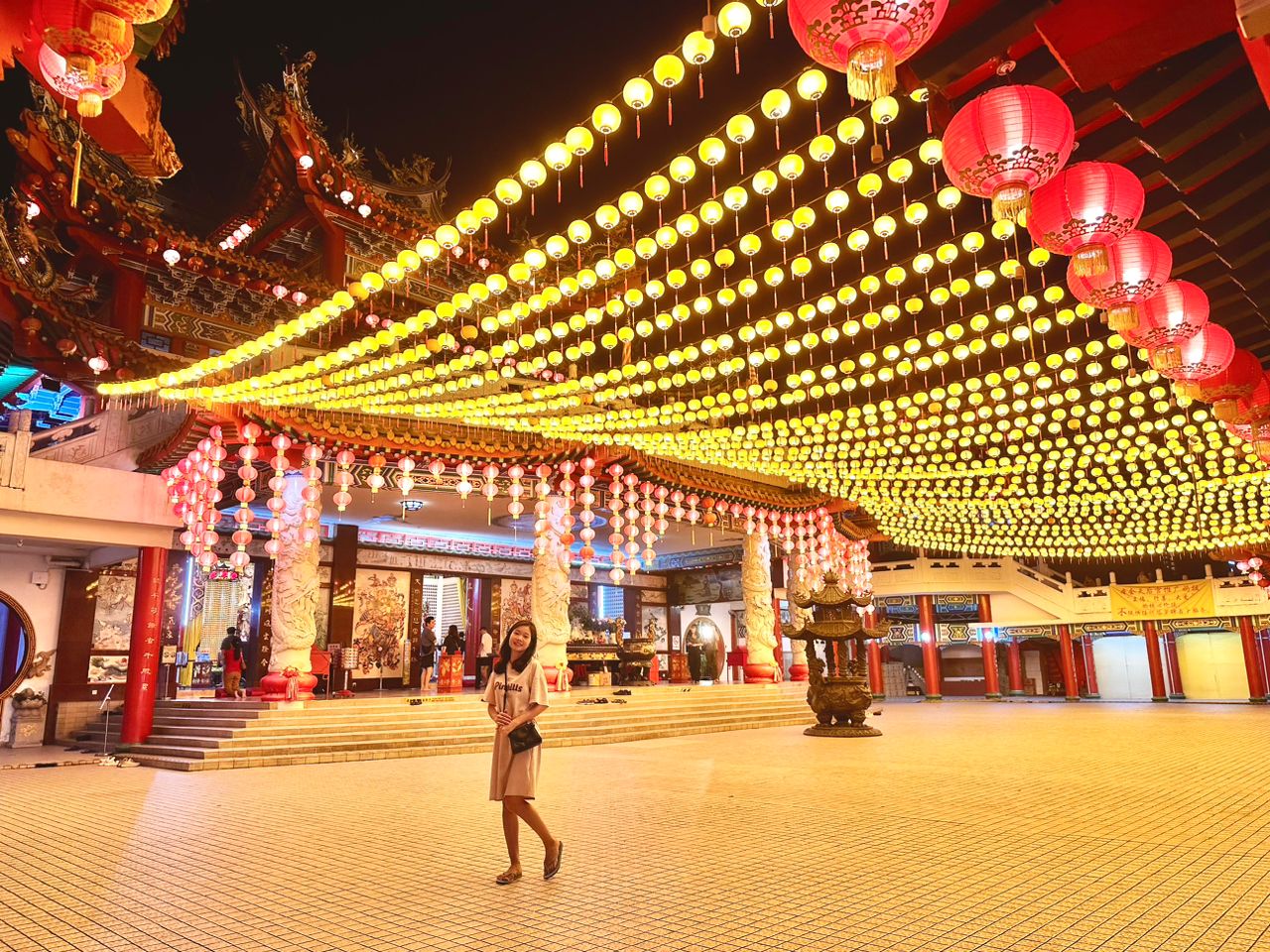
You can visit Thean Hou Temple either before or after dark..
During the daytime, you can capture stunning photographs of the temple in the sunlight. However, it can get very hot to visit the temple at this time, especially from 11:00 AM to 3:00 PM.
On the other hand, if you visit the temple at night, you have the opportunity to see beautiful illuminated lanterns, and the temperature is much cooler.
4. How to get to Thean Hou Temple?
By car
The easiest way to reach Thean Hou Temple is by car. You can use Grab (link to download Grab), which is an e-hailing app. The ride from KLCC to the temple would cost around 15 RM for a 4-seater car.
If you plan to visit multiple places by car, consider renting a car for the day, especially if you’re traveling with a large group. Feel free to contact me via WhatsApp at +60 149 776 712 or on my Instagram for the best deals (cheap price guarantee).
By public transportation
Public transportation is not the ideal option for reaching Thean Hou Temple because it requires a minimum of a 10-minute walk from the nearest bus station, and the temple is situated on a hill, which can be a little tiring when walking up to the location.
You can reach there either by bus or by LRT.
-
- By bus: From KLCC, you can take buses such as 700, P701, 734, 640, 650, and more. The nearest bus station to Thean Hou Temple is Mcoba (Bangunan Malay College Old Boys’ Association) on Jalan Syed Putra Street, which requires a 10-minute walk to the temple.
The total transportation time is approximately 30 minutes if there is no traffic. But keep in mind that buses are often not punctual in Malaysia.
-
- By LRT (Light Rail Transit): It takes about 40 minutes to reach Thean Hou Temple from KLCC. The nearest LRT station to the temple is Bangsar Station. From there, it’s approximately a 22-minute walk to the temple.
Pro tips: To get real-time directions for public transportation, you can use the Moovit app. The information in the app is pretty accurate.
By tour
Here are the recommended tours to take that includes Thean Hou Temple in the itinerary:
- Private Half-Day Batu Caves and Cultural Tour in KL
- Kuala Lumpur Instagram Tour
- Kuala Lumpur Full Day Tour
5. Restaurants near Thean Hou Temple
Here are some highly-rated restaurants that serve nice food near Thean Hou Temple:
Seni SattiSorru
- Food type: Malaysian Indian food
- Address: 113, Jalan Thamby Abdullah, Brickfields, 50470 Kuala Lumpur, Wilayah Persekutuan Kuala Lumpur
- Google rating: 4.2/5
Robson Heights Seafood Restaurant
- Food type: Chinese food
- Address: Taman Persiaran Desa, 50460 Kuala Lumpur, Federal Territory of Kuala Lumpur
- Google rating: 4/5
Annalakshmi (M) Sdn Bhd
- Food type: Vegetarian Indian food
- Address: 116, Jalan Berhala, Brickfields, 50470 Kuala Lumpur, Wilayah Persekutuan Kuala Lumpur
- Google rating: 4.5/5
Restoran Chat Masala
- Food type: Indian food
- Address: 4MHM+8C Kuala Lumpur, Federal Territory of Kuala Lumpur
- Google rating: 3.8/5
6. Best hotels near Thean Hou Temple
If you want to stay near the temple, consider these well-rated hotels:
Hotel Summer View
- Price: from RM 135/night
- Link to book: Click here
- Address: 165, Jalan Sultan Abdul Samad, Off Jalan Tun Sambathan 4, Brickfields, Brickfields, 50470 Kuala Lumpur
KL Sentral Bangsar Suites (EST) by Luxury Suites Asia
- Price: from RM 150/night
- Link to book: Click here
- Address: 44A Jalan Ang Seng, Brickfields, 50470 Kuala Lumpur
Ascott Sentral Kuala Lumpur
- Price: from RM 350 /night
- Link to book: Click here
- Address: No 211 Jalan Tun Sambanthan, Brickfields, 50470 Kuala Lumpur
Above is everything you need to know when visiting Thean Hou Temple including information about its history, what’s inside the temple, dress code, how to get there, and more.
If you have any questions, feel free to comment below. Thanks for reading!
1. What time does Thean Hou Temple close?
Thean Hou Temple closes at 10:00 p.m.
2. How to go to Thean Hou Temple by train?
You can take the LRT (Light Rail Transit) to go to the temple and get off at Bangsar Station. From there, you can walk to the temple within 25 minutes.
3. How to go to Thean Hou Temple from KL Sentral by public transportation?
From KL Sentral, the fastest way to reach the temple is by bus.
First, you walk to Nu Sentral Bus Station.
Then you take bus 640 or bus 650 to Hab Pasar Seni.
From there, take bus 734 to Bangunan Malay College Old Boys’ Association (Mcoba).
After that, you need to walk about 10 minutes to the temple.
4. How much is parking at Thean Hou Temple?
The parking rate at the temple is RM5/ car.
